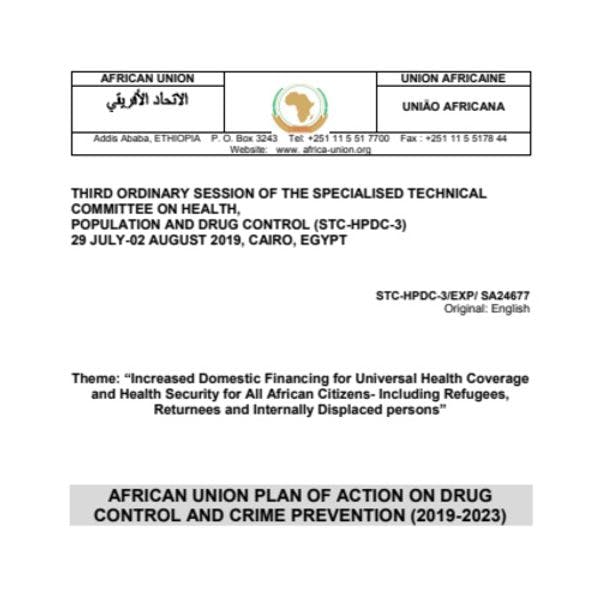African Union Plan of Action on Drug Control and Crime Prevention (2019-2023)
According to reports in 2018 from African Union Member States, the consumption and trafficking of controlled substances have escalated in all five (5) AU Regions. Growing use of cocaine, tramadol, amphetamine type stimulants (ATS), new psychoactive substances (NPS) have been stated. Heroin consumption and injection is rising in Eastern and Southern Africa resulting (in the absence of the necessary health services) in high transmission rates of HIV and hepatitis among people who inject drugs, particularly women and young people.
Large shipments of heroin are transhipped on the high seas of Eastern Africa, and that of cocaine off-shore in the Atlantic Ocean, while on-shore shipments are made through harbours and airports across the continent. Women, especially those from lowincome backgrounds, continue to be vulnerable to recruitment as drug couriers. In West, East and Southern Africa trafficking of and/or diversion from licit batches of precursor chemicals for illicit use, especially ephedrine and pseudoephedrine, occurs frequently. This takes place in areas where ATS drugs are manufactured in clandestine laboratories on a large scale, resulting in online sales of these and other drugs, including NPS.
The African Union has since 1996 adopted Action Plans to address drug control and associated crime prevention on the continent, resulting in the establishment of institutional mechanisms in Member States, Regional Economic Communities and at the AU Commission to coordinate balanced and integrated responses to the mentioned drug control challenges.
The responses encapsulated in the AU Plan of Action on Drug Control and Crime Prevention (2019-2023) (AUPA) mirrors that of the African Common Position for the 2016 UNGASS General Assembly Special Session (UNGASS) on the World Drug Problem, as well as the seven (7) chapters of Operational Recommendations of the UNGASS Outcome Document. In addition, the AUPA contains two additional pillars with objectives and activities to address crime prevention, and coordination of the implementation of the AUPA at national, regional and continental levels, respectively.
The overall objective of the AUPA (2019-2023) is to improve the health, security and socio-economic well-being of the people of Africa by addressing drug trafficking and problematic drug use in all its forms and manifestations and preventing the onset of drug use.
Objectives and outputs/activities under the nine (9) chapters or pillars address the following:
- Measures to tackle drug demand reduction and health issues associated with drug use, focusing on prevention and treatment of drug use with provisions for training of workers and professionals in these fields, parental skills training, life skills training for children and young people, reducing harm associated with drug use and implementing alternatives to punishment for drug use.
- Availability and access to controlled substances for medical and scientific purposes while preventing their diversion, with emphasis on erasing barriers that suppress accessibility to medicines, including for the relief of pain and suffering, as well as reducing non-medical use of medicines and availability of counterfeit medicines
- Measures to address drug supply reduction along with countering enablers of drug trafficking: firearms, corruption and money laundering which addresses illicit trafficking in drugs, drug law enforcement and intelligence sharing and ratification of AU instruments on combating corruption, money laundering, terrorism and trafficking in small arms.
- Measures to address crime prevention and criminal justice reform, with emphasis on international cooperation on combating transnational organized crime, fighting emerging organized crime such as cybercrime, rise in gangs, extortion, violence and criminal governance. It involves continuous assessment of fragility and vulnerability, and analysis of risk, pressures and stress factors in societies.
- Criminal justice reform, particularly addressing prison decongestion and noncustodial sentencing, is of critical importance to prevent reoffending, among others.
- Cross cutting issues on drugs and human rights pertaining to all vulnerable groups, especially youth, women, children and communities, and this pillar provides for policy makers and law enforcement authorities to be oriented on human rights to health and safety as it relates to the field of drugs, emphasizing respect for and dignity of those in treatment, as well as protective and risk factors for vulnerable girls, women, children and youths. In this regard, national epidemiological surveillance on drug use, production and trafficking, research and data collection and national drug control coordination mechanisms are critical.
- Evolving reality: trends and circumstances, emerging and persistent challenges and threats mainly focusses on countering the availability and use of NPS and ATS, sales of these drugs through the internet, and the importance of interregional forensic drug testing cooperation.
- Alternative development and alternative means of livelihood, also targeting grower communities in the agricultural sector with a specific focus on Technical, Vocational Education and Training (TVET) for youth and women employment, including economic and social infrastructure development.
- International and regional cooperation based on the principle of common and shared responsibility which makes provision for engagement with international partners for technical and financial support, for participation in regional, continental and international fora and for fast-tracking of extradition and mutual legal assistance arrangements.
- Continental, regional and national management, oversight, reporting, monitoring and evaluation of the AU Plan of Action on Drug Control and Crime Prevention (2019-2023) entails actions by the African Union Commission to account to the AU Policy Organs on the implementation and impact of the AUPA (2019-2023).
